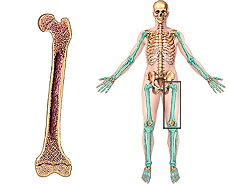Bone Marrow Transplant

Bone marrow is a spongy
tissue found inside bones. The bone marrow in the breast bone, skull, hips, ribs
and spine contains stem cells that produce the body's blood cells. These blood cells
include white blood cells (leukocytes), which fight infection; red blood cells (erythrocytes),
which carry oxygen to and remove waste products from organs and tissues; and platelets,
which enable the blood to dot
TYPES OF TRANSPLANTS
In a bone marrow transplant, the patient's diseased bone marrow is destroyed and
healthy marrow is infused into the patient's blood-stream. In a successful transplant,
the new bone marrow migrates to the cavities of the large bones, engrafts and begins
producing normal blood cells.
If bone marrow from a donor is used, the transplant is called an "allogeneic"
BMT, or "syngeneic" BMT if the donor is an identical twin. In an allogeneic
BMT, the new bone marrow infused into the patient must match the genetic makeup
of the patient's own marrow as perfectly as possible. Special blood tests are conducted
to determine whether or not the donor's bone marrow matches the patient's. If the
donor's bone marrow is not a good genetic match, it will perceive the patient's
body as foreign material to be attacked and destroyed. This condition is known as
graft-versus-host disease (GVHD) and can be life-threatening. Alternatively, the
patient's immune system may destroy the new bone marrow. This is called graft rejection.
There is a 35 percent chance that a patient will have a sibling whose bone marrow
is a perfect match. If the patient has no matched sibling, a donor may be located
in one of the international bone marrow donor registries, or a mis-matched or autologous
transplant may be considered.
In some cases, patients may be their own bone marrow donors. This is called an autologous
BMT and is possible if the disease afflicting the bone marrow is in remission or
if the condition being treated does not involve the bone marrow (e.g. breast cancer,
ovarian cancer, Hodgkin's disease, non-Hodgkin's lymphoma, and brain tumors). The
bone marrow is extracted from the patient prior to transplant and may be "purged"
to remove lingering malignant cells (if the disease has afflicted the bone marrow).

 Bone marrow is a spongy
tissue found inside bones. The bone marrow in the breast bone, skull, hips, ribs
and spine contains stem cells that produce the body's blood cells. These blood cells
include white blood cells (leukocytes), which fight infection; red blood cells (erythrocytes),
which carry oxygen to and remove waste products from organs and tissues; and platelets,
which enable the blood to dot
Bone marrow is a spongy
tissue found inside bones. The bone marrow in the breast bone, skull, hips, ribs
and spine contains stem cells that produce the body's blood cells. These blood cells
include white blood cells (leukocytes), which fight infection; red blood cells (erythrocytes),
which carry oxygen to and remove waste products from organs and tissues; and platelets,
which enable the blood to dot